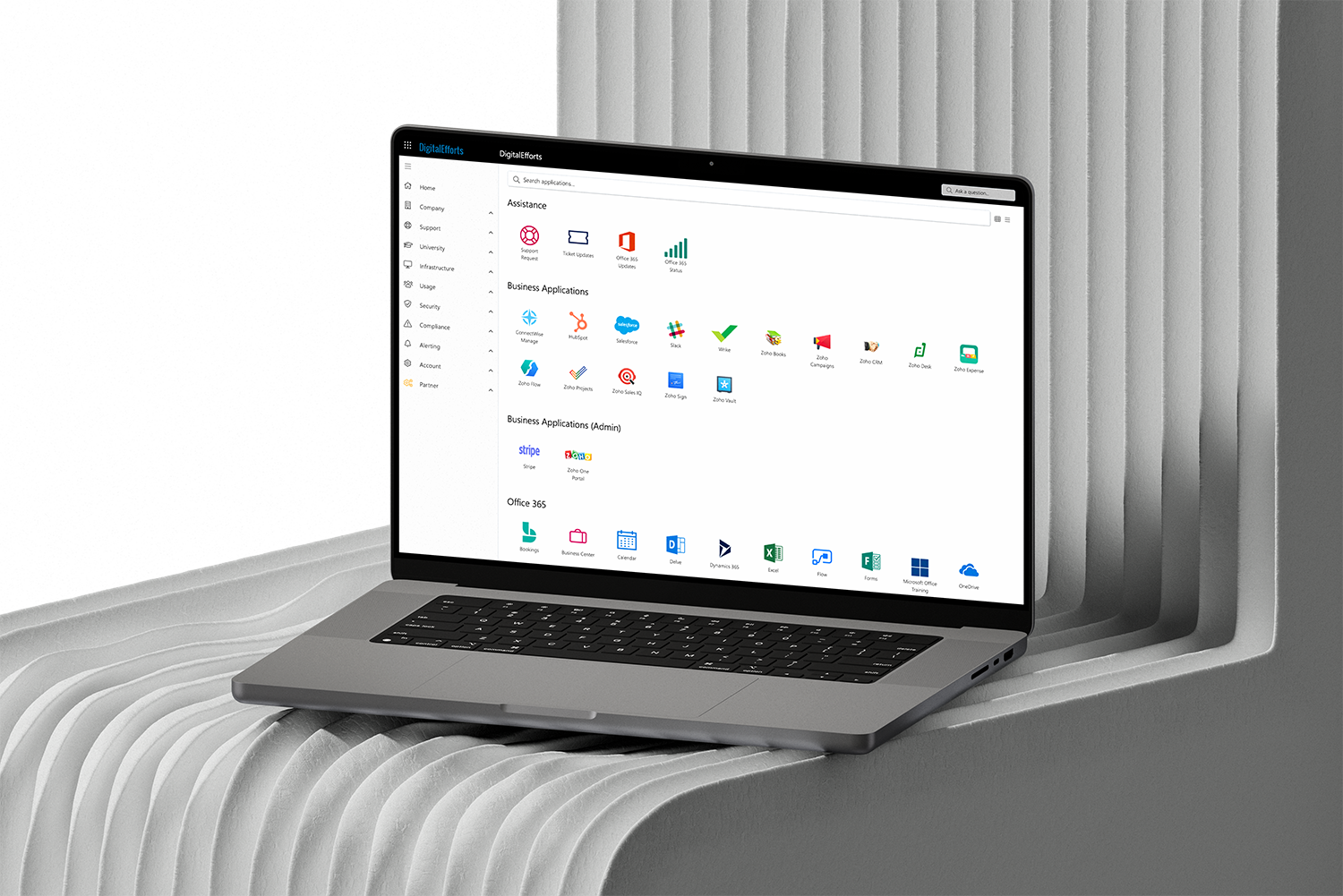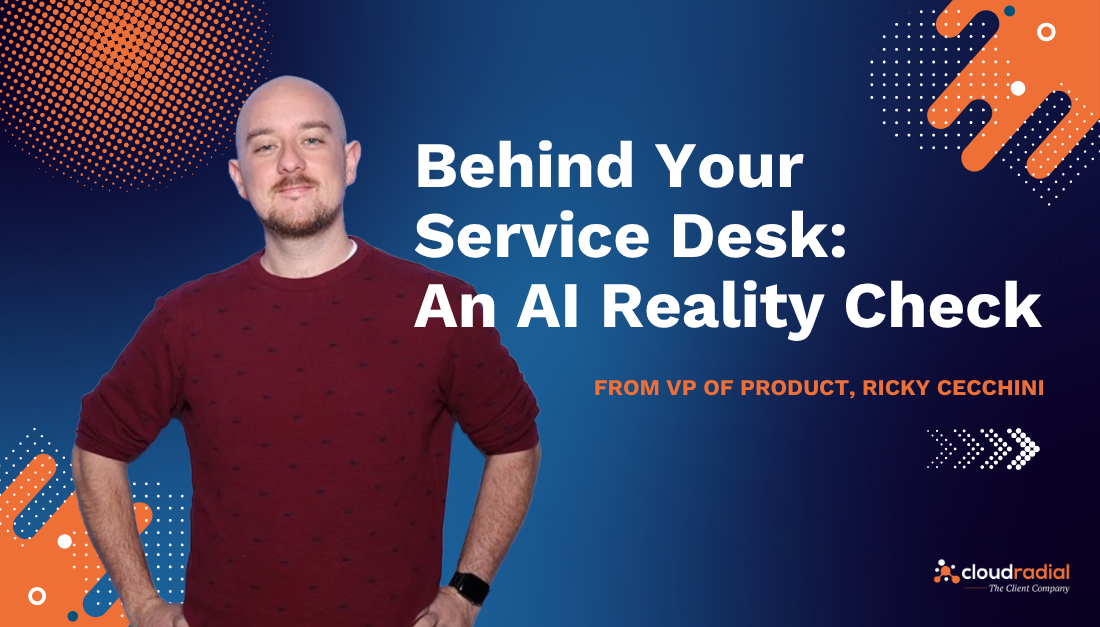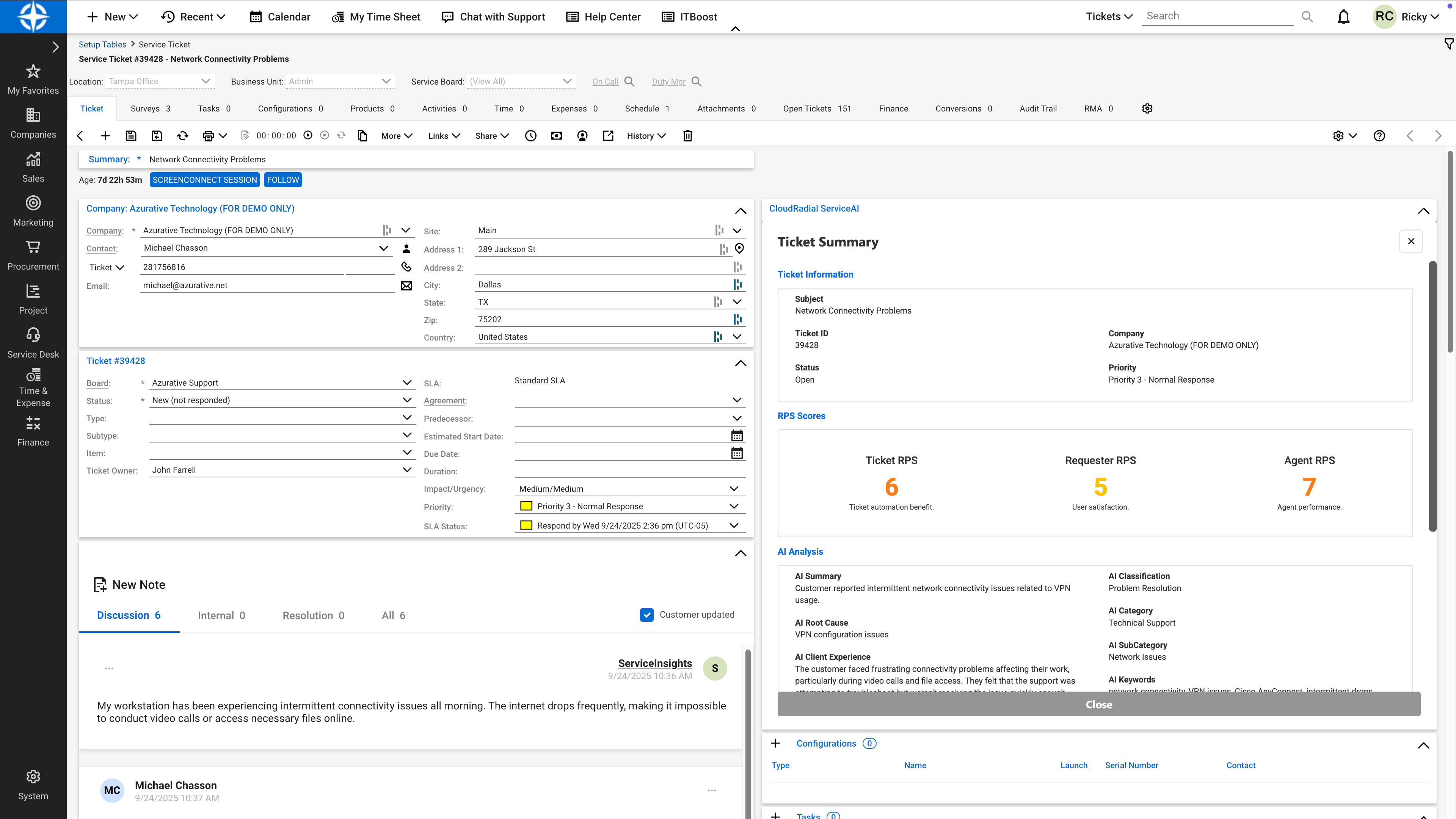Transforming Your MSP Service Desk from the Inside: Lessons from Team Metalogic's ServiceAI Journey
Based on a conversation between Ricky Cecchini (VP of Product, CloudRadial) and Mike Parfitt (CEO, Team Metalogic) on ServiceAI, CloudRadial's...
Get everything you need for the ultimate client experience
Enterprise-grade infrastructure with the flexibility MSPs demand
Perfectly tailored AI that knows your specific MSP

Build your own Shopify-like store with your PSA products & distributors
Have clients to submit tickets directly to your PSA, freeing up your team's time
Pre-triage and route tickets correctly with the help of AI
Deliver instant, accurate answers that can help achieve zero-touch resolution
You'll learn things like how to add revenue without adding cost, MSP best practices, and how to master client management.
4 min read
 CloudRadial
:
June 25, 2025
CloudRadial
:
June 25, 2025

Every MSP knows the feeling: you've invested thousands in the perfect tech stack, your automation is humming along nicely, and your team knows the tools inside and out. Yet somehow, managing clients still feels scattered and difficult to scale.
Each new client becomes a custom project, your team spends more time explaining processes than executing them, and switching vendors becomes a logistical nightmare that affects every client relationship.
The problem isn't your tools—it's the layer you're probably neglecting entirely.
Most successful MSPs have mastered two of the three critical service delivery layers:
The operational layer sits at the foundation of everything you do. This is your PSA, RMM, backup tools, security stack—the technical infrastructure that keeps your clients' businesses running. If you're reading this, you've likely got this layer locked down.
The integration layer connects all those operational tools together. Whether it's native integrations between ConnectWise and your preferred RMM, or custom workflows that automate ticket routing, this layer determines how efficiently your tools work together. Most mature MSPs have invested heavily here too.
But there's a third layer that's often treated as an afterthought: the client-facing layer.
This is where your clients actually interact with your services. It's their portal experience, how they submit tickets, where they access reports, and how they communicate with your team. For most MSPs, this layer is a patchwork of different tools, processes, and experiences that vary wildly from client to client.
And that's exactly where the problems begin.
Picture this scenario: Client A is your biggest account. They've got a custom portal setup, specific communication channels, and unique processes that took months to establish. Client B has a completely different setup because they were onboarded when you were using different tools. Client C uses mostly standard processes, but they have unique workflow requirements that mean their experience is different from everyone else's.
Sound familiar?
This fragmentation creates a cascade of problems that touches every part of your business:
Documentation becomes a nightmare. Instead of one set of processes to document and maintain, you're managing dozens of different workflows. Your team needs separate playbooks for each client, and knowledge transfer becomes nearly impossible.
Training costs skyrocket. New technicians don't just need to learn your tools—they need to learn how each client uses those tools differently. What works for Client A might be completely wrong for Client B.
Quality becomes inconsistent. Some clients get amazing service because you have superstar techs who know their setup intimately. Others get mediocre service because their assigned tech is still learning their unique requirements.
Tool changes become organizational disasters. When you want to switch PSAs or upgrade your RMM, you're not just changing your operational layer—you're potentially breaking the client experience for dozens of different custom setups.
The hidden cost? Every new client becomes "arduous to onboard and manage," eating into your profitability and limiting your ability to scale.
Here's where most MSPs get stuck: they know standardization would solve these problems, but they're terrified of losing the customization that their clients demand.
The good news? This is a false choice.
The goal isn't to make every client identical—it's to standardize your processes while maintaining the flexibility to customize when necessary. Think of it like a restaurant: the kitchen has standardized processes for food prep, cooking, and plating, but they can still accommodate dietary restrictions and special requests.
For MSPs, this means creating a base template for client experiences that can be customized without rebuilding everything from scratch.
Effective service delivery standardization starts with three key principles:
Consistent onboarding: Every new client should go through the same basic setup process, regardless of their specific requirements. This doesn't mean identical services—it means identical processes for understanding needs, setting expectations, and delivering initial value.
Transparent communication: Clients should always know where to go for updates, how to submit requests, and what to expect from your team. Whether they're accessing reports, submitting tickets, or reviewing service updates, the experience should be consistent and predictable.
Operational flexibility: Your client-facing systems should be independent enough from your operational tools that you can make backend changes without disrupting the client experience.
The magic happens in how you connect your client-facing processes to your operational tools. Instead of building custom integrations for each client, focus on creating flexible systems that can adapt to different operational requirements while maintaining a consistent client experience.
For example, your ticket submission process should work the same way for every client from their perspective—they fill out a form, get a confirmation, and can track progress. But on the backend, those tickets should route to different PSA boards, priorities, and teams based on each client's specific service agreement.
This approach gives you the best of both worlds: clients get a consistent, professional experience while you maintain the flexibility to deliver services according to their unique requirements.
One of the biggest benefits of standardizing your client-facing layer is vendor independence. When your client experience is tightly coupled to specific operational tools, switching vendors becomes a client-facing disaster. Every tool change requires client retraining, new documentation, and often, uncomfortable conversations about why everything is different now.
But when your client-facing systems are properly abstracted from your operational tools, you can negotiate better vendor agreements, adopt new technologies faster, and future-proof your business without constant client disruption.
Imagine being able to switch from ConnectWise to Autotask, or from one backup vendor to another, without a single client noticing the change. That's the power of proper service delivery standardization.
Your clients don't care about your PSA, your RMM, or your backup solution. They care about results: reliable service, clear communication, and consistent experiences. By standardizing your client-facing layer while maintaining operational flexibility, you can deliver better client experiences while dramatically reducing your internal complexity.
The investment in standardizing service delivery pays dividends in reduced training costs, improved client satisfaction, faster onboarding, and the flexibility to evolve your business without breaking client relationships.
Most importantly, it frees you to focus on what you do best: delivering exceptional IT services instead of managing an ever-growing maze of custom processes.
The question isn't whether you can afford to standardize your service delivery—it's whether you can afford not to.
Want to learn more about standardizing your service delivery? Watch now!

Based on a conversation between Ricky Cecchini (VP of Product, CloudRadial) and Mike Parfitt (CEO, Team Metalogic) on ServiceAI, CloudRadial's...

I thought I knew what would happen when we unleashed AI on the MSP world. I was wrong.

Purpose-Built AI Technology trained on an MSP's tickets and support documentation to scale technical expertise and achieve zero-touch resolution